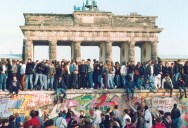This Day In History – November 9th

THE GREAT BOSTON FIRE OF 1872 – NOV. 9, 1872

The Great Boston Fire of 1872 was Boston’s largest urban fire, and still ranks as one of the most costly fire-related property losses in American history. The conflagration began at 7:20 p.m. on November 9, 1872, in the basement of a commercial warehouse at 83—87 Summer Street in Boston, Massachusetts. The fire was finally contained 12 hours later, after it had consumed about 65 acres (26 ha) of Boston’s downtown, 776 buildings and much of the financial district, and caused $73.5 million in damage. At least 20 people are known to have died in the fire.
Factors that contributed to Boston’s Great Fire:
– Boston’s building regulations were not enforced. There was no authority to stop faulty construction practices.
– Buildings were often insured at full value or above value. Over-insurance meant owners had no incentive to build fire-safe buildings. Insurance-related arson was common.
– Flammable wooden French Mansard roofs were common on most buildings. The fire was able to spread quickly from roof to roof, and flames even leapt across the narrow streets onto other buildings. Flying embers and cinders started fires on even more roofs.
– Fire alarm boxes in Boston were locked to prevent false alarms, therefore delaying the Boston Fire Department by twenty minutes.
– Merchants were not taxed for inventory in their attics, therefore offering incentive to stuff their wood attics with flammable goods such as wool, textiles, and paper stocks.
– Fire hydrant couplings were not standardized.
– The number of fire hydrants and cisterns was insufficient for a commercial district.
– Steam engine pumpers were not able to draw enough water to reach the wooden roofs of tall downtown buildings.
– Gas supply lines connected to street lamps and used for lighting in buildings could not be shut off promptly. Gas lines exploded and fed the flames.
[Source]


THE GREAT LAKES STORM OF 1913 – NOV. 9, 1913

The deadliest and most destructive natural disaster ever to hit the lakes, The Great Lakes Storm of 1913, historically referred to as the “Big Blow”, the “Freshwater Fury” or the “White Hurricane”, was a blizzard with hurricane-force winds that devastated the Great Lakes Basin in the Midwestern United States and the Canadian province of Ontario from November 7 through November 10, 1913. The storm was most powerful on November 9, battering and overturning ships on four of the five Great Lakes, particularly Lake Huron. Deceptive lulls in the storm and the slow pace of weather reports contributed to the storm’s destructiveness.
The Great Lakes Storm killed more than 250 people, destroyed 19 ships, and stranded 19 others. The financial loss in vessels alone was nearly US $5 million, or about $100 million at current value. This included about $1 million at current value in lost cargo totalling about 68,300 tons, such as coal, iron ore, and grain.
The storm originated as the convergence of two major storm fronts, fueled by the lakes’ relatively warm waters—a seasonal process called a “November gale”. It produced 90 mph (145 km/h) winds, waves over 35 feet (11 m) high, and whiteout snowsqualls. Analysis of the storm and its impact on humans, engineering structures, and the landscape led to better forecasting and faster responses to storm warnings, stronger construction (especially of marine vessels), and improved preparedness. [Source]

Bodies from the Wexford washed ashore near Goderich, Ontario. Source photo: Institute for Great Lakes Research, Bowling Green State University
KRISTALLNACHT: THE NIGHT OF BROKEN GLASS – NOV. 9, 1938

Kristallnacht, also to referred to as the Night of Broken Glass, and also Reichskristallnacht, Pogromnacht, and Novemberpogrome, was a pogrom or series of attacks against Jews throughout Nazi Germany and parts of Austria on November 9–10, 1938.
Jewish homes were ransacked, as were shops, towns and villages, as SA stormtroopers and civilians destroyed buildings with sledgehammers. Around 1,668 synagogues were ransacked, and 267 set on fire. In Vienna alone 95 synagogues or houses of prayer were destroyed.
Martin Gilbert writes that no event in the history of German Jews between 1933 and 1945 was so widely reported as it was happening, and the accounts from the foreign journalists working in Germany sent shock waves around the world. The Times wrote at the time: “No foreign propagandist bent upon blackening Germany before the world could outdo the tale of burnings and beatings, of blackguardly assaults on defenceless and innocent people, which disgraced that country yesterday.”
The trigger of the attacks was the assassination of German diplomat Ernst vom Rath by Herschel Grynszpan, a German-born Polish Jew in Paris, France. Kristallnacht was followed by further economic and political persecution of Jews, and is viewed by historians as part of Nazi Germany’s broader racial policy, and the beginning of the Final Solution and the Holocaust. [Source]


CAMBODIA GAINS INDEPENDENCE FROM FRANCE – NOV. 9, 1953

Cambodia, officially known as the Kingdom of Cambodia, is a country located in the southern portion of the Indochina Peninsula in Southeast Asia. With a total landmass of 181,035 square kilometres (69,898 sq mi), it is bordered by Thailand to the northwest, Laos to the northeast, Vietnam to the east, and the Gulf of Thailand to the southwest. With a population of over 14.8 million, Cambodia is the 69th most populous country in the world. The official religion is Theravada Buddhism which is practiced by around 95% of the Cambodian population.
In 1863 King Norodom, who had been installed by Thailand, sought the protection of France from the Thai and Vietnamese after tensions grew between them. In 1867 the Thai king signed a treaty with France, renouncing suzerainty over Cambodia in exchange for the control of Battambang and Siem Reap provinces which officially became part of Thailand.
The provinces were ceded back to Cambodia by a border treaty between France and Thailand in 1906. Cambodia continued as a protectorate of France from 1863 to 1953, administered as part of the colony of French Indochina, though occupied by the Japanese empire from 1941 to 1945. Between 1874 and 1962, the total population increased from about 946,000 to 5.7 million. After King Norodom’s death in 1904, France manipulated the choice of king, and Sisowath, Norodom’s brother, was placed on the throne. The throne became vacant in 1941 with the death of Monivong, Sisowath’s son, and France passed over Monivong’s son, Monireth, feeling he was too independently minded. Instead, Norodom Sihanouk, a maternal grand-son of king Sisowath was enthroned. The French thought young Sihanouk would be easy to control. They were wrong, however, and under the reign of King Norodom Sihanouk, Cambodia gained independence from France on November 9, 1953. [Source]

FIRST ISSUE OF ROLLING STONE IS PUBLISHED – NOV. 9, 1967

Rolling Stone is a US-based magazine devoted to music, liberal politics, and popular culture that is published every two weeks. Rolling Stone was founded in San Francisco in 1967 by Jann Wenner (who is still editor and publisher) and music critic Ralph J. Gleason.
The magazine was known for its political coverage beginning in the 1970s, with the enigmatic and controversial gonzo journalist Hunter S. Thompson. Rolling Stone magazine changed its format in the 1990s to appeal to younger readers, often focusing on young television or film actors and pop music.
To get the magazine off the ground, Wenner borrowed $7,500 from his family members and from the family of his soon-to-be wife, Jane Schindelheim. The first issue carried a cover date of November 9, 1967. Rolling Stone magazine was initially identified with and reported on the hippie counterculture of the era. However, the magazine distanced itself from the underground newspapers of the time, such as Berkeley Barb, embracing more traditional journalistic standards and avoiding the radical politics of the underground press.
In the very first edition of the magazine, Wenner wrote that Rolling Stone “is not just about the music, but about the things and attitudes that music embraces.” This has become the de facto motto of the magazine. Rolling Stone began to make a mark for its political coverage, with the likes of gonzo journalist Hunter S. Thompson writing for the magazine’s political section. Thompson would first publish his most famous work Fear and Loathing in Las Vegas within the pages of Rolling Stone, where he remained a contributing editor until his death in 2005. [Source]

John Lennon has been featured on the cover of Rolling Stone more than 30 times. The most of any artist or musician in the magazine’s history
GARRY KASPAROV BECOMES YOUNGEST WORLD CHESS CHAMPION
NOVEMBER 9, 1985

Garry Kimovich Kasparov, born 13 April 1963 in Baku, Azerbaijan, is a Russian (formerly Soviet) chess grandmaster, a former World Chess Champion, writer, political activist, and one of the greatest chess players of all time. Kasparov became the youngest ever undisputed World Chess Champion in 1985 at the age of 22.
He held the official FIDE world title until 1993, when a dispute with FIDE led him to set up a rival organization, the Professional Chess Association. He continued to hold the “Classical” World Chess Championship until his defeat by Vladimir Kramnik in 2000. He is also widely known for being the first world chess champion to lose a match to a computer under standard time controls, when he lost to Deep Blue in 1997.
Kasparov’s ratings achievements include being rated world No. 1 according to Elo rating almost continuously from 1986 until his retirement in 2005 and holding the all-time highest rating of 2851. He was the world No. 1 ranked player for 255 months, by far the most of all-time and nearly three times as long as his closest rival, Anatoly Karpov.
Kasparov announced his retirement from professional chess on 10 March 2005, to devote his time to politics and writing. He formed the United Civil Front movement, and joined as a member of The Other Russia, a coalition opposing the administration of Vladimir Putin. He was considered to become a candidate for the 2008 Russian presidential race, but later withdrew. Widely regarded in the West as a symbol of opposition to Putin, Kasparov’s support in Russia is low. [Source]

FALL OF THE BERLIN WALL – NOVEMBER 9, 1989

The Berlin Wall was a barrier constructed by the German Democratic Republic (GDR, East Germany) starting on 13 August 1961, that completely cut off West Berlin from surrounding East Germany and from East Berlin. The barrier included guard towers placed along large concrete walls, which circumscribed a wide area (later known as the “death strip”) that contained anti-vehicle trenches, “fakir beds” and other defenses. The Eastern Bloc claimed that the wall was erected to protect its population from fascist elements conspiring to prevent the “will of the people” in building a socialist state in East Germany. In practice, the Wall served to prevent the massive emigration and defection that marked Germany and the communist Eastern Bloc during the post-World War II period.
Before the Wall’s erection, 3.5 million East Germans circumvented Eastern Bloc emigration restrictions and defected from the GDR, many by crossing over the border from East Berlin into West Berlin, from where they could then travel to West Germany and other Western European countries. Between 1961 and 1989, the wall prevented almost all such emigration. During this period, around 5,000 people attempted to escape over the wall, with estimates of the resulting death toll varying between 100 and 200.
In 1989, a radical series of political changes occurred in the Eastern Bloc, associated with the liberalization of the Eastern Bloc’s authoritarian systems and the erosion of political power in the pro-Soviet governments in nearby Poland and Hungary. After several weeks of civil unrest, the East German government announced on 9 November 1989 that all GDR citizens could visit West Germany and West Berlin. Crowds of East Germans crossed and climbed onto the wall, joined by West Germans on the other side in a celebratory atmosphere. Over the next few weeks, a euphoric public and souvenir hunters chipped away parts of the wall; the governments later used industrial equipment to remove most of the rest. The fall of the Berlin Wall paved the way for German reunification, which was formally concluded on 3 October 1990. [Source]

Short section of the Berlin Wall at Potsdamer Platz (Berlin, Germany). The white painted text in the upper third of the section reads: “At this place, the first crevice/hole in the Berlin Wall was created”. Photograph by Jorge Lascar

Sign up to get our BEST stories of the week straight to your inbox.




